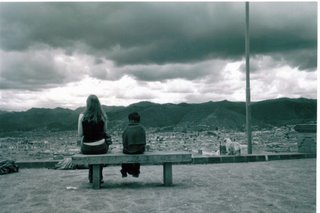My Peru pics are submitted for your viewing enjoyment. i chose what i thought were the best, and most representative ones. All of the photos were taken on disposable cameras, mostly Kodak, though i think we used a Fuji too, and there was one black and white cam that Abby and i agreed would make for some artsy shots, though i'm disappointed that one photo i took of a nearly full moon rising over the town of Puno on Lake Titicaca didn't come out (and is therefore not featured here). there were bunches of rejects: early on, the tendency is to embrace those out-the-window-of-the-bus shots as gold, pure, mom-pleasing gold, but they rarely come out. Another seducer of the tourist with camera is the landscape shot, and in a place with the geography (topography) of Peru, landscapes unfold around every corner. our trip to Colca Canyon, reachable from Arequipa by car (though, as we learned later, we payed way too much to the small tour company), should have offered vistas unrivaled in the west hemisphere, as the Canyon is said to be deeper, and more dramatic-looking, than our own Grand Canyon. unfortunately, as you can see from the photos, the giant cloud that engulfed the overlook rendered the canyon completely and utterly hidden from view, meaning no breathtaking sightings of soaring condors, majestic scavengers. there are shots of us looking out at the Colca Valley, west of the canyon and uncovered by clouds; you can make out the ancient agricultural terraces carved into the sides of the rocky terrain to maximize land area and facilitate easier irrigation, feats performed by the Pre-Columbian peoples of that region a long time ago (there's a picture of Abby and Sean, metaphorically connected by a tiny bridge over the Colca River, tiny because of how far off it is, though in reality likely large and certainly more recently constructed). Our Machu Picchu shots are easy to identify, as they include numerous views of the ancient Inca holy city-retreat, constructed, i think, in the 15th century, then abandoned when the Inca went to war with the Spanish. Despite vanquishing and all but obliterating the Inca, who were an elite ruling-class of people, distinct from the indigenous pre-Columbians who had lived there for thousands of years before the rise of the Inca, the Spanish never found Machu Picchu. the sacred valley is fed by the Urubamba River, which surrounds the Machu Picchu site on three sides, thousands of feet below. It is an incredible natural site, one that offers incredible natural sights, and it is thrillingly extreme because of both the wonderous setting of mountain peaks and valley vistas, and, more cerebrally, for its very remoteness--surely there can be no place like this on earth-- and for the staggering knowledge of how much human effort went into the construction of the city (coupled with the knowledge of how little concrete knowledge we actually have of the Inca). i chewed coca while exploring the site, which was lush and green. the coca helped me combat the exhaustion of hiking on little sleep, and yeah, we were at close to 10,000 feet. Coca, a leaf, is and was revered as a holy substance by Inca and pre-Columbian peoples alike (the Quechua, Aymara "Indians", and others, the Amazonian peoples), and has been cultivated by humans for 20,000 years. the leaf, chewed or brewed in tea, is non-narcotic, but it has a noticeable, though subtle effect. Check out our photos of Lake Titicaca: Abby and i took a bunch of shots from our day on the lake, which was sunny and beautiful and required vigilance with regards to sunscreen. there's a black and white one of me swimming in the lake, which i did for approximately 30 seconds, though it was refreshing and not so cold. Lake Titicaca's claim to fame is its absurd name, and the fact that it rests at a robust 13,000 or so feet above sea level, making it the highest altitude navigable lake in the world. it was hard to sleep in Puno the first two nights, pulse racing, emotions high. then there is Cusco, the old Inca capitol; a bunch of photos, many B & W's, and a few featuring William, a friend we made there. William sold finger puppets to tourists, mainly by throwing them a game of guilt and charm, not necessarily in that order. often, a tourist in Peru finds him or herself being approached by people selling things, and the phrase that one employs most often is "no gracias". but in William's case, he quickly realized that i wasn't going to be buying so many hand puppets, but was susceptible to more subtle courtship. he would bound over to us frequently, and we spent one of our last days in Peru with him, at the courtyard of a church overlooking Cusco, playing with a beat-up hackey-sack of his, and i broke my flip-flop, to his great delight. if i ever return to Peru, one thing i'll do, and maybe even the secret reason why i would return, would be to find William. i love that kid. lastly, there are pictures from Lima, featuring our little band of brothers and a sister or two. more later: for now, enjoy.




























